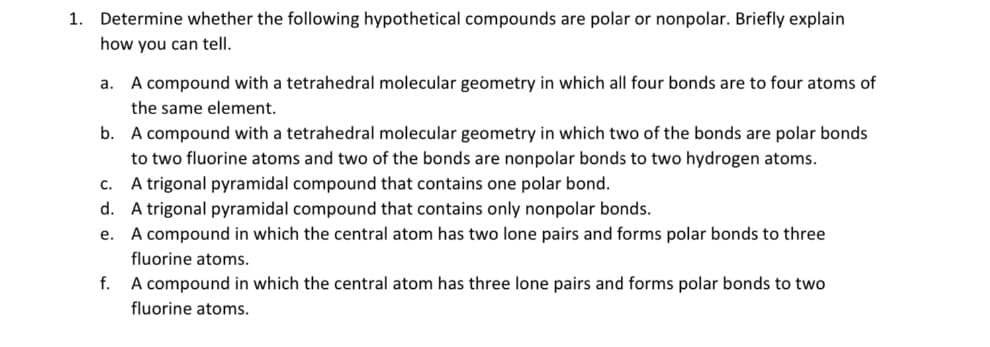Determine whether the following hypothetical compounds are polar or nonpolar. Briefly explain how you can tell. a. A compound with a tetrahedral molecular geometry in which all four bonds are to four atoms of the same element. b. A compound with a tetrahedral molecular geometry in which two of the bonds are polar bonds to two fluorine atoms and two of the bonds are nonpolar bonds to two hydrogen atoms. c. A trigonal pyramidal compound that contains one polar bond.
Determine whether the following hypothetical compounds are polar or nonpolar. Briefly explain how you can tell. a. A compound with a tetrahedral molecular geometry in which all four bonds are to four atoms of the same element. b. A compound with a tetrahedral molecular geometry in which two of the bonds are polar bonds to two fluorine atoms and two of the bonds are nonpolar bonds to two hydrogen atoms. c. A trigonal pyramidal compound that contains one polar bond.
ChapterU2: Smells: Molecular Structure And Properties
Section: Chapter Questions
Problem 8STP
Related questions
Question

Transcribed Image Text:1. Determine whether the following hypothetical compounds are polar or nonpolar. Briefly explain
how you can tell.
a. A compound with a tetrahedral molecular geometry in which all four bonds are to four atoms of
the same element.
b. A compound with a tetrahedral molecular geometry in which two of the bonds are polar bonds
to two fluorine atoms and two of the bonds are nonpolar bonds to two hydrogen atoms.
c. A trigonal pyramidal compound that contains one polar bond.
d. A trigonal pyramidal compound that contains only nonpolar bonds.
e. A compound in which the central atom has two lone pairs and forms polar bonds to three
fluorine atoms.
f.
A compound in which the central atom has three lone pairs and forms polar bonds to two
fluorine atoms.
Expert Solution
This question has been solved!
Explore an expertly crafted, step-by-step solution for a thorough understanding of key concepts.
This is a popular solution!
Trending now
This is a popular solution!
Step by step
Solved in 3 steps

Recommended textbooks for you


Chemistry by OpenStax (2015-05-04)
Chemistry
ISBN:
9781938168390
Author:
Klaus Theopold, Richard H Langley, Paul Flowers, William R. Robinson, Mark Blaser
Publisher:
OpenStax

Introductory Chemistry: A Foundation
Chemistry
ISBN:
9781337399425
Author:
Steven S. Zumdahl, Donald J. DeCoste
Publisher:
Cengage Learning


Chemistry by OpenStax (2015-05-04)
Chemistry
ISBN:
9781938168390
Author:
Klaus Theopold, Richard H Langley, Paul Flowers, William R. Robinson, Mark Blaser
Publisher:
OpenStax

Introductory Chemistry: A Foundation
Chemistry
ISBN:
9781337399425
Author:
Steven S. Zumdahl, Donald J. DeCoste
Publisher:
Cengage Learning

Principles of Modern Chemistry
Chemistry
ISBN:
9781305079113
Author:
David W. Oxtoby, H. Pat Gillis, Laurie J. Butler
Publisher:
Cengage Learning

World of Chemistry, 3rd edition
Chemistry
ISBN:
9781133109655
Author:
Steven S. Zumdahl, Susan L. Zumdahl, Donald J. DeCoste
Publisher:
Brooks / Cole / Cengage Learning

Chemistry: Matter and Change
Chemistry
ISBN:
9780078746376
Author:
Dinah Zike, Laurel Dingrando, Nicholas Hainen, Cheryl Wistrom
Publisher:
Glencoe/McGraw-Hill School Pub Co